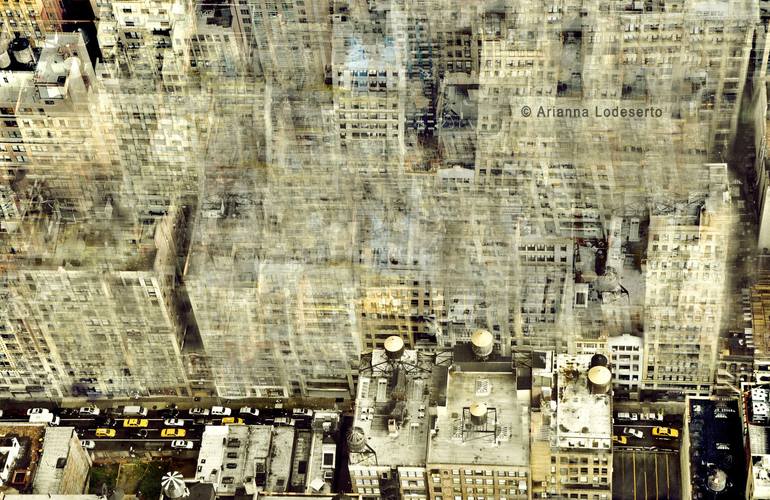





VIEW IN MY ROOM
Taxi Cab Print - Limited Edition of 1
Italy
Select a Material
Fine Art Paper
Select a Size
8 x 12 in ($40)
Add a Frame
White ($80)
Artist Recognition

Artist featured in a collection
About The Artwork
Paradigm for the exploitation of congestion, the first idea of Manhattan, retrospectively defined Manhattanism, was imposed in 1811 by the formulation of The Manhattan Grid. The work of DeWitt, Morris and Rutherford, the grid aimed at regulating the growing building exploitation of the island. Through its “houses with straight sides and right angles” yet to be built, the rigid insatiable design – consisting of 12 avenues in a straight line and 155 streets and 2028 rectangular blocks rarely interrupted by green space or other topographical solutions – followed maximum functionality for the smallest space and maximum economic yield. The prearranged rectangles that make up the blocks were a model that could be adapted to any other American city, a matrix intended for hectic vertical and horizontal development, joints of ever replaceable building blocks. The Manhattan Grid is an example of aménagement of the urban space that Foucault sought in all other places. We find similarity to those blocks in the ranks that allow for micro-segmentarities and the movement of these segments, dowels of a sequential geometry, of an “architectural control” that operates through location or quadrillage (to every individual his place and in every place its individual)[1]: Manhattan space is optimized, deprived of remainders and dead moments. Manhattan is as we have always imagined it, it’s “a utopian Europe, the product of compression and density”, a furious synthesis of efficiency, agglomeration of buildings that can always expand and absorb crisis, where the new rectangle immediately overlaps the old, for “The Grid defines a new balance between control and decontrol in which the city can be at the same time ordered and fluid, a metropolis of rigid chaos”. Glassy verticalization of movement, Manhattan is constantly submitting its forms to a perpetual present, to an obstinate self-multiplication where faster and faster verses sing a landscape devoted to the discipline of a blink. “Whatever happens, it will have to happen somewhere within the 2028 blocks of the Grid”, therefore “the city becomes a mosaic of episodes, each with its own particular life span, that contest each other through the medium of the Grid”. Like Manhattan and Paris, each laboratory of disciplinary urbanism dreams of a general and omnivorous visibility, a panoptic vision experimented yesterday by the pioneers of photography, and today from Google Earth, which controls almost every suburb from the top of any centre, every shred of urbanized territory. Every topos is now potentially controllable, even without a precise goal: the permanent record optimizes the time of capture a priori. Waiting for other retroactive manifestos, far from that approximate grid laid out on the screens of every computer, we venture to the top of high rises, but we can’t comprehend the whole city, we can’t orient ourselves and identify the old structure. The aerial photomontage defuses the urban material to portray the ghosts of the functionalist mirage, their restless skeletons, the crowd of houses and towers, the animality of taxicabs stopped along the path, the metropolitan mass that is both dispersed and sheltered, solitary and compressed, barbaric and restrained. In deformation, the image scrapes the grid-palimpsest and forces the observer onto a different kind of journey: it is a document of disorder, of the opacity generated from the utopia of the analytic space, of man’s congestion in his ranks.
Original Created:2010
Subjects:Aerial
Materials:PlasticSoft (Yarn, Cotton, Fabric)Other
Mediums:ManipulatedDigital
Details & Dimensions
Print:Giclee on Fine Art Paper
Size:8 W x 12 H x 0.1 D in
Size with Frame:13.25 W x 17.25 H x 1.2 D in
Frame:White
Ready to Hang:Yes
Packaging:Ships in a Box
Shipping & Returns
Delivery Time:Typically 5-7 business days for domestic shipments, 10-14 business days for international shipments.
Handling:Ships in a box. Art prints are packaged and shipped by our printing partner.
Ships From:Printing facility in California.
Have additional questions?
Please visit our help section or contact us.
I usually retract the concrete matter of the "third landscape" and its inhabitants, in order to document the iron, the rust, the cement, the urban shape that breaks down. My intent is not to denounce the degradation of some industrial areas waiting for the rezoning: the photographic act seeks rather to "read" those suspended places and heterotopias. If history can't rehabilitate their original function, the danger is to contemplate them as mausoleums, like an aesthetic sublimation of the necropolis of fatigue. Instead one could consider the hidden life in the apparent stasis, developing a lexicon of images that will take into account the mutability of every place. Recently, I have furthermore attempted to question the documentary approach in landscaping. In front of the omnipresence of images, I try to disassemble what has already appeared, to not leave intact what is protected by the frame. Immaturity advances, sight is not enough.
Artist Recognition

Artist featured by Saatchi Art in a collection
Thousands Of Five-Star Reviews
We deliver world-class customer service to all of our art buyers.
Global Selection
Explore an unparalleled artwork selection by artists from around the world.
Satisfaction Guaranteed
Our 14-day satisfaction guarantee allows you to buy with confidence.
Support An Artist With Every Purchase
We pay our artists more on every sale than other galleries.
Need More Help?